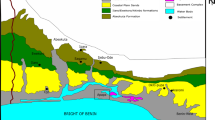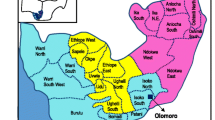Abstract
Geophysical well logging methods (including borehole flow logging) can significantly contribute to a detailed understanding of hydrogeological conditions in basins with complicated sedimentary structure in studies undertaken to make optimal use of water sources, or to protect those resources from contamination. It is a common practice to delineate geological and hydrogeologic conditions at the scale used in geological maps and surface surveys. However, there is a need for more detailed descriptions of basin structure for many tasks related to water resources management and hydrologic research. This paper presents four specific examples of boreholes in complex hydrogeologic settings where useful information was provided by geophysical logging: (1) identification of large-scale upward cross-flow between aquifer horizons in an open borehole; (2) confirmation of continuous permeability throughout a long borehole interval; (3) identification of leakage into a test well via a defective casing joint; (4) evidence for downward flow in open boreholes; and (5) identification of permeable beds associated with water inflows during aquifer tests. These borehole geophysical measurements provide important information about the detailed lithological profiles of aquifers (especially in the absence of core), enabling the optimization of groundwater monitoring, resource use, and wellhead protection activities.






Similar content being viewed by others
References
Datel JV, Kobr M (2007) Thermal waters of the Usti nad Labem area: optimalization of their use on the basis of new hydrogeological and well-logging data. In: Proceedings of XXXIV IAH Congress “Groundwater and Ecosystems”, pp 198–199, Lisbon 17–21, September 2007
Datel JV, Krasny J (2005) Thermal waters of the Usti nad Labem and Decin region (in Czech). Podzemna voda XI, 2:230–242. SAH, Bratislava, Slovakia
Domenico PA, Schwartz FW (1998) Physical and chemical hydrogeology, 2nd edn. Wiley, New York
Fetter CW (2001) Applied hydrogeology. Prentice Hall, Upper Saddle River
Fitts CR (2002) Groundwater science. Academic Press, San Diego
Grinbaum I (1965) Geophysical methods in the study of filtration properties of rocks. Nedra, Moscow
Guerin R (2005) Borehole and surface-based hydrogeophysics. Hydrogeol J 13:251–254
Hazdrova M, Kacura G, Krasny J, Malkovsky M (1968) Hydrogeology of the Teplice and Usti area. J Geol Sci, Ser HIG (Hydrogeol Eng Geol) 6:1–207 Prague (in Czech)
Hearst JR, Nelson PH, Paillet FL (2003) Well logging for physical properties. Wiley, Chichester
Hercik F, Herrmann Z, Valecka J (1999) Hydrogeology of the Bohemian Cretaceous Basin (in Czech). Cesky geol. ust, Praha
Keys WS (1990) Borehole geophysics applied to groundwater investigations, US Geological Survey Publication TWRI 2-E2
Kobr M, Krasny J (2000) Well-logging in regional hydrogeology: the Police Cretaceous Basin. Eur J Environ Eng Geophys 6:47–60
Kobr M, Linhart I (1994) Geophysical survey as a basis for regeneration of waste dump Halde 10, Zwickau Saxony. J Appl Geoph 31:107–116
Kobr M, Valcarce RM (1989) Geophysical logging of engineering-geological boreholes in the San Blas region. Acta Universitatis Carolinae, Geologica 3:339–352, Charles University, Prague
Kobr M, Mares S, Paillet FL (2005) Geophysical well logging. In: Rubin Y, Hubbard S (eds) Hydrogeophysics. Water Science and Technology Library. Springer, Dordrecht, pp 291–331. ISBN 1-4020-3101-4.
Mares S, Zboril A (1970) Simultaneous fluid resistivity and temperature logging and its use in hydrogeological wells. J Geol Sci Ser UG (Appl Geophys) 9:103–114
Molz F, Morin RH, Hess EA, Melville JG, Gueven O (1989) The impeller for measuring aquifer permeability variations: evaluation and comparison with other tests. Water Resour Res 25(7):1677–1683
Paillet FL, Senay Y, Mukhopadhyay A, Szekely F (2000) Flowmetering of drainage wells in Kuwait City, Kuwait. J Hydrol 234(3–4):208–22
Paillet FL, Williams JH, Oki DS, Knutson KD (2002) Comparison of formation and fluid column logs in a heterogeneous basalt aquifer. Ground Water 40:577–585
Pitrak M, Mares S, Kobr M (2007) A simple borehole dilution technique in measuring horizontal ground water flow. Ground Water 45(1):89–92
Rushton KR (2005) Groundwater hydrology, conceptual and computational models. Wiley, Chichester
Todd DK, Mays LW (2005) Groundwater hydrology. Wiley, Hoboken
Williams JH, Paillet FL (2002) Using flow meter pulse tests to define hydraulic connections in the subsurface: a fractured shale example. J Hydrol 265(1–4):100–117
Zboril A, Mares S (1971) Photometry in the solution of complicated conditions in hydrologic wells. J Mineral Geol 16(2):113–131
Acknowledgments
This research and paper has been supported by the Czech research projects GACR 205/07/0691 and 205/07/0777 and the Institutional research project of the Czech Ministry for Education 0021620855. Authors would like to thank the Czech Hydrometeorological Institute (www.chmi.cz) and AQUATEST Co. (www.aquatest.cz), Department of Geophysics, for well logging results from the European project ISPA/FS Nr. 2000/CZ/16/P/PE/003, and also to Dr. Vratislav Nakladal, a great authority on hydrogeology of this region, for his efficient help.
Author information
Authors and Affiliations
Corresponding author
Rights and permissions
About this article
Cite this article
Datel, J.V., Kobr, M. & Prochazka, M. Well logging methods in groundwater surveys of complicated aquifer systems: Bohemian Cretaceous Basin. Environ Geol 57, 1021–1034 (2009). https://doi.org/10.1007/s00254-008-1388-8
Received:
Accepted:
Published:
Issue Date:
DOI: https://doi.org/10.1007/s00254-008-1388-8




